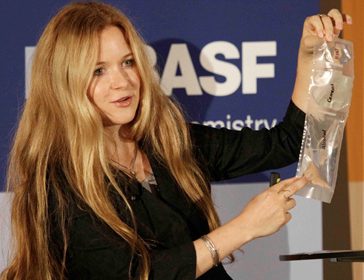For many years engineers have dreamed about building habitable structures on the Moon or Mars. Those structures will have to be sturdy and stable, which begs the question, why not use concrete? But can ready mixed concrete be successfully formulated in the unique atmospheric conditions of the lunar or Martian surface? That is a question scientists are seeking to answer. And recently completed experiments conducted on the International Space Station (ISS) may bring us closer to that answer.
|
|
| Dr. Aleksandra Radlińska |
 |
| Mark Bury |
BASF Construction Chemicals convened a panel discussion last month at Beachwood, Ohio, headquarters to shed light on the experiments. Panelists were BASF Admixture Systems Product Manager Mark Bury and Penn State University’s Dr. Aleksandra Radlińska who, along with National Aeronautics and Space Administration’s Dr. Richard Grugel, designed experiment protocols and two packages of construction materials that were launched into space this past May. BASF Technology Manager Paul Horst Seiler moderated the program.
NASA-funded research—officially named Microgravity Investigation of Cement Solidification (MICS)—will enable scientists to analyze the hydration reaction and microstructure formation in cement pastes that solidify in a microgravity environment.
“What we are facing is the challenge of mixing materials in an environment where gravity does not allow those materials to settle as they would on Earth,” Radlińska explained. “The on-orbit portion of MICS consists of hydrating dry cement powders in a series of experiments which vary the type of cement or cement compound; the type of additives; the number of additives; the amount of water; and the time until hydration is arrested at fixed intervals.”
Processing of the MICS samples onboard the ISS craft included removing a sample from the kit and squeezing a burst pouch to rupture the seal, ejecting the water solution into the cement powder compartment. After the water solution was injected into the cement compartment, the crew mixed the ingredients by kneading and/or using a small rubber spatula—an idea refined by BASF’s Bury—in order to create a paste-like consistency. After mixing, the crew applied a clip to contain the paste in a single compartment of the MICS sample for a prescribed amount of time before the application of isopropyl alcohol from a third compartment to arrest cement hydration. According to NASA:
- The MICS investigation supports the evaluation of microstructure and material properties of benchmark cement samples.
- Different responses to thermal and mechanical loading are expected and will be characterized in detail.
- Positive attributes found in the hardening process due to the microgravity environment aboard the ISS will be reported with the intent of improving Earth-based cement and concrete processing.
One of the ultimate goals of identifying a proper product formulation is to someday 3-D print a domed structure in an actual zero gravity environment. In addition, a useable ready mixed formulation will ideally have to be characterized by crystal growth that could seal cracks or micro-fissures—hence, self-healing concrete.
Of course, any future ready mixed operation on the Moon or Mars would have to utilize existing raw materials. “Tests have previously been conducted on aggregate with similar composition to those found on Moon and Mars,” said Radlińska, “and all indications are this can be done.”
More than 120 samples mixed in space have now returned to Earth and are in the process of being evaluated and analyzed by Juliana Neves, the Penn State graduate student leading the project. Results will be available in the near future. Additional experiments are also being developed for future space flights.
“Evaluation of the samples and applying the findings are the first steps toward making and using concrete on extraterrestrial bodies,” Radlińska affirmed.
Mark Kuhar is Editor of Rock Products, a Semco Publishing sister title of Concrete Products.
